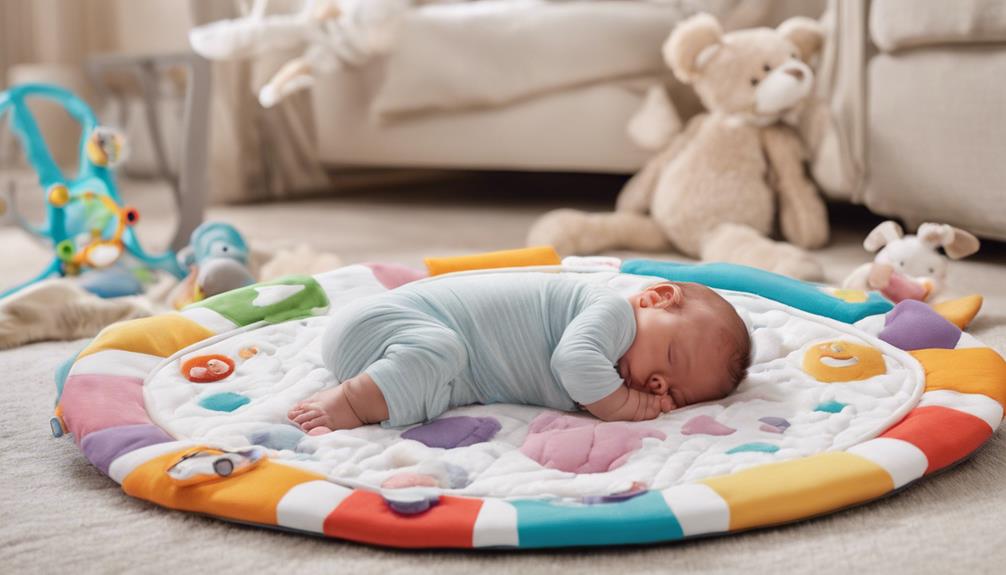As we explore the world of newborn care, deciphering the world of diaper changes can often feel like decoding a secret language.
Have you ever wondered what your baby's pee and poop could be telling you about their health?
Let's investigate how understanding the subtle cues in your little one's elimination habits can provide valuable insights into their well-being.
Key Takeaways
- Monitoring diaper changes helps track newborn health and hydration levels.
- Pee color and frequency provide essential health insights for newborns.
- Different poop colors and consistencies indicate various health conditions.
- Regular observation of urine color, clarity, and consistency aids in proactive health management.
Pee and Poop Frequency
Within the first few days post-birth, understanding the frequency of your newborn's pee and poop is important for monitoring their well-being and development. Your newborn's pee frequency is a critical indicator of their health. Typically, newborns have their first pee within the initial 24 hours after birth. As days pass, the number of wet diapers should increase, with around 4-6 wet diapers per day being normal after the first week. If you notice your baby producing fewer than four wet diapers a day, it could signal potential issues such as illness, fever, or inadequate feeding.
On the other hand, excessive peeing, marked by six or more wet diapers per day in the first month of breastfeeding, can actually be a positive sign. When it comes to the color of your baby's pee, shades of yellow are normal, ranging from light to dark. However, darker shades may indicate dehydration, prompting the need for increased fluid intake. Monitoring these aspects closely can help you make sure your newborn is healthy and thriving.
Color Meanings

Understanding the color meanings of your newborn's poop can provide valuable insights into their health and potential issues that may require attention. When it comes to deciphering the hues of your baby's bowel movements, here are some key points to keep in mind:
- Bright green baby poop in breastfed infants: This color might indicate a dietary imbalance or an excess of foremilk, which could affect your baby's digestion.
- Red baby poop: Seeing red in your baby's stool can be alarming as it may signify blood in the stool. It's important to identify the source of the bleeding and consult a healthcare provider promptly.
- White or gray baby poop: These colors could point to liver issues or nutrient malabsorption. Seeking medical advice is essential to address any underlying concerns affecting your baby's health.
Being attentive to the colors in your baby's diaper can help you stay proactive in ensuring their well-being and addressing any potential problems promptly.
Consistency Guide
Observing the consistency of your newborn's poop can provide valuable insights into their digestive health and overall well-being. For breastfed babies, poop is typically seedy, soft, and mustard-like, while formula-fed babies tend to have firmer stools resembling peanut butter or soft pudding. It's important to pay attention to any deviations from these norms.
Watery or liquid poop may indicate diarrhea, which can lead to dehydration if not addressed promptly. On the other hand, hard, pellet-like poop could signal constipation, making it uncomfortable for your little one. Changes in poop consistency can be influenced by various factors such as diet, hydration, and digestive health.
Newborn Urine Color

As we shift our focus to 'Newborn Urine Color,' it's important to highlight that normal newborn urine color typically ranges from pale yellow to dark yellow. It's common for parents to have concerns about their newborn's urine color, so let's explore what's considered normal and what might warrant further attention.
- Orange Tinge with Crystals: Seeing an orange tinge with crystals in your newborn's urine is quite common and usually not a cause for alarm.
- Unusual Colors: Keep an eye out for red, pink, or brown hues in your baby's urine, as these colors may indicate the presence of blood and should prompt a discussion with your healthcare provider.
- Cloudy Urine: While cloudy urine with color changes can be a sign of a possible infection, consulting your healthcare provider if you notice such changes in your newborn's urine is important.
Types of Baby Poop
Baby poop comes in various textures and colors, serving as an important indicator of a newborn's digestive health. Meconium, the initial greenish-black stool, is a mix of amniotic fluid, bile, mucus, and skin cells. For breastfed babies, poop is seedy and mustard-like, while formula-fed infants typically have yellow-tan poop resembling toothpaste.
Normal baby poop colors range from yellow to green to brown, with red or black hues signaling potential gastrointestinal issues. Breastfed baby poop is fancy mustard-like, and formula-fed poop can be likened to beat-up flan or pudding in texture. Consistency varies, from thick as peanut butter to as mushy as cottage cheese.
Constipation results in hard stools, while diarrhea leads to watery poop. Observing these variations helps parents monitor their baby's digestive system for any irregularities.
Frequently Asked Questions
What Is the Timeline of Newborn Poops?
We have you covered on the timeline of newborn poops! Typically, newborns pass meconium within 24 hours, shifting to yellowy-green stools in a few days. Breastfed babies may go 2-5 times daily, while formula-fed babies usually go once.
How Much Poop Counts as a Dirty Diaper Newborn?
We usually consider any diaper with stool as dirty for newborns. It's a good sign, showing their digestive system is working well. Breastfed babies might have more dirty diapers due to efficient digestion. Formula-fed babies may have fewer.
What Is Abnormal Poop for Newborns?
Abnormal newborn poop colors like chalky white, red, or black may signal health issues. Unusual textures like hard pellets can mean constipation. Red flecks or bloody stools need prompt attention. Any changes should be discussed with a doctor.
How Many Wet Diapers Should a Newborn Have in 24 Hours?
We aim to provide comfort and guidance. A newborn typically needs at least one wet diaper in their first 24 hours to show hydration. By day 5, they should have 5-6 wet diapers.
Conclusion
Through tracking your newborn's pee and poop patterns, you can gain valuable insights into their health and well-being. Remember, every baby is unique, so variations in frequency, color, and consistency are normal.
Trust your instincts as a parent and consult your healthcare provider if you have any concerns. By staying informed and observant, you can guarantee your baby is happy and healthy.










